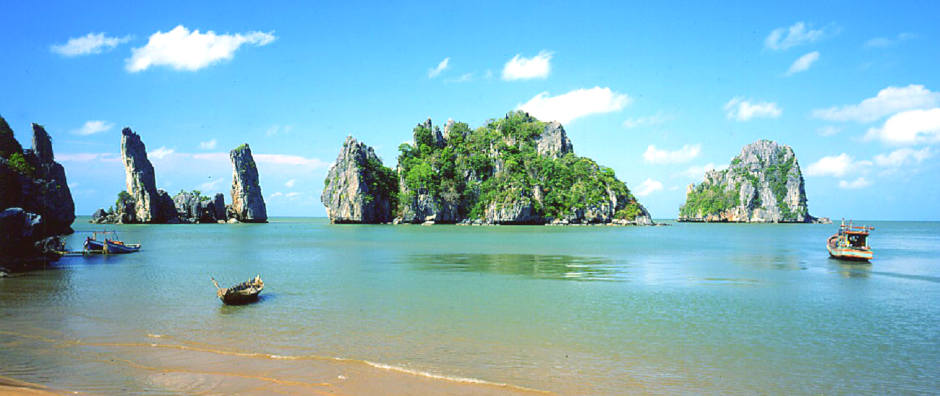HA TIEN
Ha Tien is a district-level town in Kiên Giang Province, Mekong Delta of Vietnam. Ha Tien is a popular tourist site of the region thanks to its beautiful beaches and landscapes.
Ha Tien may be part of the Mekong Delta but lying on the Gulf of Thailand it feels a world away from the rice fields and rivers that typify the region. There are dramatic limestone formations peppering the area, which are home to a network of caves, some of which have been turned into temples. Plantations of pepper trees cling to the hillsides. On a clear day, Phu Quoc Island is easily visible to the west.

Location of Ha Tien
Ha Tien is a seaside town in Kien Giang Province in the Mekong Delta. It lies 100km from Chau Doc, 340km from Ho Chi Minh City and very close to the Cambodian border. South of Ha Tien lies To Chau River and Ho Dong, East Lake, lies in the east, which is more an inlet of the sea. Local legends say that when there is a full moon, fairies come to Ho Dong to dance and bathe. That is how the city got its name, because ‘Tien’ in Vietnamese means ‘Fairy’.
History of Ha Tien
Ha Tien was established in 1674 by a small group of Chinese people. They supported the Ming Dynasty and opposed the Qing Dynasty. They were led by Mo Jiu also known as Mạc Cuu. When in the 17th century the Qing dynasty was defeated, Mac Cuu, born in Guangdong in China, fled to Ha Tien. He took his followers and other interested people with him and they settled there under the reign of Lord Nguyen. When they arrived in south Vietnam, the Nguyen Lords ordered the King of the Khmer to grant land to them. The Chinese built markets in this place and turned it into a busy business town. Vietnamese people gradually arrived here. During the 17th and 18th century the area was invaded and pillaged several times by the Thais. The Khmer governor turned to the Nguyen Lords for support in 1708 when again the Thai threatened the area. In August 1708, Lord Nguyen Phuc Chu appointed Mac Cuu division commander of Ha Tien. The area became Vietnamese territory when Mac Cuu delivered its sovereignty to the Nguyen Lords and he was conferred the position of ruler of this town. He governed this area as a fiefdom under the protection of the Nguyen Lords and became part of Vietnam. He was succeeded by his son, Mac Thien Tu in 1735. Mac Thien Tich became the new governor and he expanded the territory towards the right bank of Hau river. During the American War Ha Tien was the first base for ‘swift boat operations’ along the south Vietnamese rivers. Eventually, operations extended the length of the Giang Thanh River and all the way to the Bassac River. Ha Tien became the western anchor for such operations, but was never a really major base. In the late 1970’s, the area came under attack from the Khmer Rouge. The Cambodian forces repeatedly attacked the Vietnamese territory and massacred thousands of civilians here and forced many more to flee to safety. This prompted the Vietnamese army to enter Cambodia to rid it of the evil regime. The area north of Ha Tien, along the Cambodian border, was sown with mines and booby traps, which have yet to be cleared. In 1995 a French film company chose the city to produce the movie “L’amant” (The lover).
Ha Tien Today Ha Tien is surrounded by grassland, wetland and limestone karst ecosystems. The area is rich in biodiversity, particularly birds and cave animals. You will also see many cement factories which use the karst mountains to transform it in cement. The people in this area live of the cement production as well as cultivating shrimp and rice farming.
=
To do and see in Ha Tien
Binh Son Mountain
On this mountain you can find the tombs of the Mac Cuu family and is located north of the centre.
Khmer-style wat
The Khmer-style wat is located just out of town and emphasises that many Khmer people live here.
Mac Cuu Family Tombs
This Mac Cuu family played a prominent role in the history of Ha Tien. The tombs of the Mac Cuu family are not far from the town. The hill where they lie is known locally as Nui Lang, the hill of the tombs. Mac Cuu and several dozen of his relatives are buried here in traditional Chinese tombs decorated with figures of dragons, phoenixes, lions and guardians. The tomb of Mac Cuu is the largest. It was built in 1809 and it features a white tiger and a green dragon.
Market
There are several large markets in Ha Tien. Near the riverfront and the bridge over the Dong Ho inlet is the fish, meat and fruit market. There is also a large new covered market for clothes and household goods. In the evening there is a large night market, around the old market hall, situated in Tuan Phu Dat opposite the Ha Tien floating restaurant on the Dong Ho inlet.
Mui Nai Beach
Ha Tien is famous for its beautiful landscapes. It has many beaches and mountains. Mui Nai is one of the most beautiful beaches in Ha Tien. Next to the beach, there is a small market that sells sea food such as lobsters, sea crabs and squids. You can also buy souvenirs which are made from tortoise-shells.
Phat Duong Pagoda
This pagoda was built in 1914 and reconstructed in 1937.
Phu Dong Pagoda
There is an old and a new Phu Dong Pagoda. They are both located on Binh San Mountain. In 1969 the old pagoda, with a length of 12 metres and width of 9 metres, was discovered. It had collapsed around 1833. When it was discovered many objects were found intact, such as: brass incense burner, porcelain jars, a jar of raw rice. In 1846 a new pagoda was constructed on a different part of the mountain. It is not clear why it got the same name. This pagoda was founded in the 18th century by the daughter-in-law of Mac Cuu, Nguyen Thi Xuan. Her tomb is located near the pagoda. Only one monk continues to live there.
Statue of Mac Cuu
The statue is located on a square near To Chau bridge.
Tam Bao Pagoda
This pagoda was founded by Mac Cuu in 1730. It is now home to several Buddhist nuns. In front of the pagoda is a statue of Quan The Am Bo Tat standing on a lotus blossom in the middle of a pond. Inside the largest statue on the dais is of A Di Da, the Buddha of the past. It is made of bronze, but has been painted. Outside the building are the tombs of 16 monks.
How to get to Ha Tien
By boat
There are daily ferries to Phu Quoc, depending on the weather.
By bus
There are buses from Ha Tien to Ho Chi Minh City, Can Tho, Rach Gia or Chau Doc and many other destinations. You can cross the border that lies about 7km north of Ha Tien to go to Cambodia.
By car or motorbike
Ha Tien is 92km from Rach Gia, 95km from Chau Doc, 206km from Can Tho and 338km from HCMC. There are not many ways as Ha Tien lies at the sea and near the border.
By plane
There is no airport in Ha Tien. You can fly to Rach Gia and take the bus or a taxi from there.
Getting around in Ha Tien
The centre of town is walkable as it is small. To get to the sights that lie farther away you can either hire a motorcycle taxi or a normal taxi. You can also rent a motorbike by the day bicycle.
Weather in Ha Tien
The average temperature is 27º C with the highest in April and lowest in January. The dry season is from December to April and the rainy season is from May to November.
